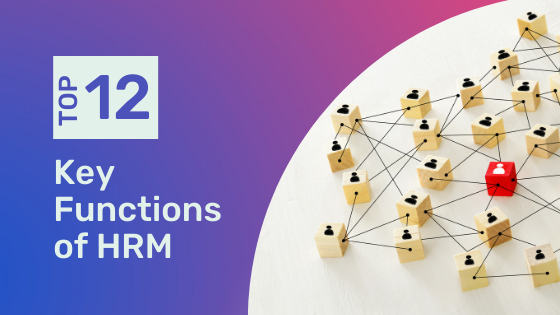
HR departments take on many vital functions, from recruitment to learning and development to performance management. These functions are called the key functions of HRM (Human Resource Management). If you are an HR practitioner or planning to become one, it is important that you know all about these functions. And understands how they work together to help your organization achieve its goals. This article will provide you with information on all these key functions of HRM. Also how they work together as a whole to help your organization succeed.
Here’s what we’ll cover Recruitment – responsible for providing organizations with a sufficient supply of potential employees. Performance Management, Learning, and Development ensure an employee’s knowledge, skills, abilities, and characteristics. Business objectives and needs, and many other essential factors are all aligning with each other. So Let’s start together.
Table of Contents
What is HR?
Human resources (HR) refers to all people-related aspects of a business, from training and training on Recruitment to employee relations and performance management. The term is often used synonymously with personnel or human resources. But personnel refers to hiring new employees while human resources cover everything else. More simply, HR is in charge of ensuring that a company’s employees are taken care of both on and off the job.
1) Human resource planning
Human resource planning is one of several functions that help an organization succeed. A well-planned human resources department can enable companies to maintain their competitive edge. That’s because most organizations are composed in whole or in part of people, and people management is one of today’s most essential functions.
2) Recruitment and Selection
Recruitment is a key function of human resources management and involves attracting suitable applicants for a position. Advertising vacancies can do this through various channels, including newspapers, job search sites, and online forums. To attract candidates with relevant skills, companies will often offer incentives such as signing bonuses or accommodation allowances to successful recruits. After reviewing many applications, employers will then select suitable candidates for an interview.
3) Training & Development
Training & Development is one of HR’s core functions. It ensures that employees are well-train, have all relevant skills to perform their duties, and contribute effectively to overall organizational goals. Training programs should provide clear goals, complete with a deadline and completion date, and measurable objectives. This helps trainees know what they are going to achieve by completing a course or program.

4) Performance Management
Performance management is an integral part of human resource management. It is an effective tool for a manager or supervisor to set and monitor employees’ goals. In addition, it is also an excellent way to increase job satisfaction and engagement by making sure that employees have a clear understanding of their goals and how they are evaluating those goals.
5) Career Planning
One of your primary functions as a human resources manager is to keep employees informed about how you can help them achieve their career goals. This means you will likely be in touch with employee progress regularly, and keeping track of an employee’s performance should be something you do annually, at least. Performance reviews are not just for measuring job performance; they are also opportunities for employees to discuss areas that need improvement or things they would like to achieve within their role.

6) Function Evaluation
Most businesses realize that their human resources are critical to their success, and therefore recognize that a department that performs functions such as recruiting and performance management is crucial. But what about functions like learning and development? The mistake many business owners make when considering human resources is assuming that they do not need to perform these essential functions just because they have good people working for them. Nothing could be further from the truth.
7) Compensation & Benefits
Compensation and benefits, sometimes referred to as human resources or HR, are essential functions in any organization. Without a solid compensation and benefits strategy, your organization may be struggling to attract top talent. Compensation includes salary, bonuses, and retirement plans; benefits include health insurance and vacation time. Many organizations also offer additional perks such as work-life balance programs and other incentives that encourage employee happiness with their job.
8) Industrial Relations
Another key function of human resources management is its role in industrial relations. In many companies, HR’s task is with overseeing matters of employment and discipline, as well as grievances and disputes. These functions are referred to as industrial relations—the relationship between employees and their employers in terms of conditions, benefits, employment status, etc. These functions are essential when there is a trade union or labor union representing workers.
9) Health & Safety
The core job of Health & Safety is protecting workers from potential hazards and accidents, which can happen in almost any type of organization. It’s easy to forget that there are real people behind every business; businesses aren’t machines—they’re made up of humans who face health and safety risks every day. It’s not just about preventing injuries: it’s also about ensuring well-being and providing opportunities for growth through fair treatment by management.
10) Employee Participation and Communication
Communication is essential to make sure all employees know company goals and their part in achieving those goals. Participation helps build commitment to those goals by providing everyone with a voice and a stake in how to do things. This kind of participation gives workers a sense that they’re not just being told what to do but rather involved in what gets done. It can also help mitigate turnover.

11) Administrative responsibilities
Administrative responsibilities of Human Resource Management include, but the limit is not 1. Recruitment and selection: It can say a lot about a company when it hires an employee from outside. We have to make the choices regarding hiring by considering various factors. Such as candidate’s qualifications, knowledge about the industry and organization, credentials such as educational qualification, experience in similar positions, etc. This is one crucial aspect that forms a strong base for any organization.
12) Personal well-being
Perhaps one of the most critical functions of an organization’s human resources department is ensuring employee well-being. Without feeling happy and healthy, employees won’t be able to do their best work. And as research has shown, good health leads to a happier workforce. To that end, part of an effective human resources department is engaging in wellness initiatives (such as group exercise classes or educational seminars on nutrition) to help improve employee health and well-being.
Conclusion
There are many key human services that can be provided by a human resources department. These include recruitment, performance management, learning and development, and compensation planning. Also administration, benefits and wellness management, workforce planning, and management development. Every business is different in what it wants from its HR department. However, these functions are necessary for any organization looking to create a workplace culture where employees are valued as people first.
Managing compliances are one of the most underestimated functions of human resource management. But it isn’t. Even a tiny miscalculation can owe you huge penalties & regret would be the only reaction.